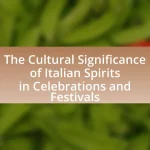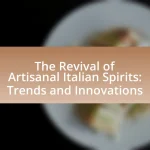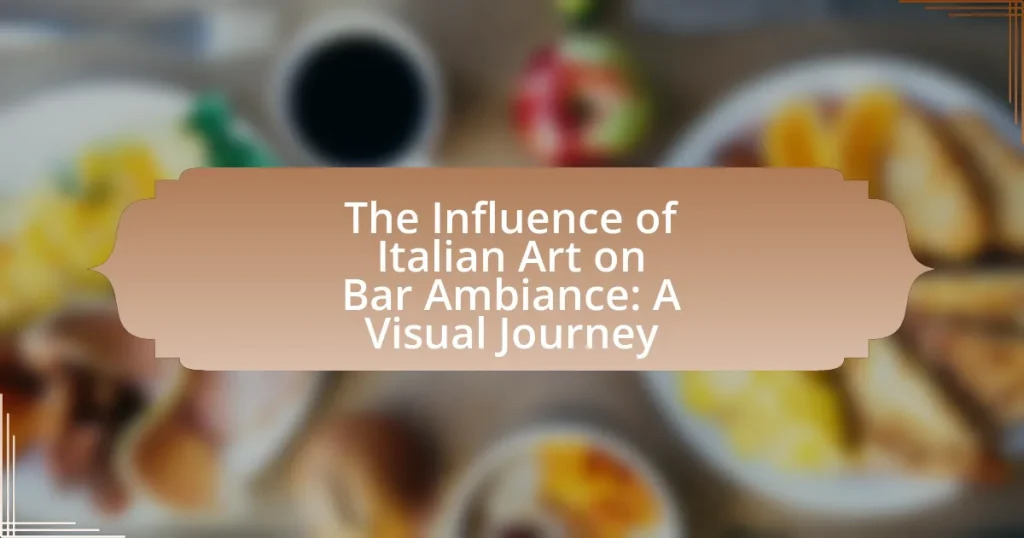The article examines the influence of Italian art on bar ambiance, highlighting how elements such as color, texture, and design contribute to creating inviting and sophisticated environments. It discusses the significance of various artistic styles, including Renaissance and Baroque, and their role in enhancing social interaction and customer satisfaction. Additionally, the article explores practical ways for bar owners to incorporate Italian art into their establishments, emphasizing the benefits of using authentic artworks to elevate the overall aesthetic and brand identity. Key characteristics of Italian art, regional influences, and the psychological impact of art on patrons are also addressed, providing a comprehensive overview of how Italian art shapes the bar experience.

What is the Influence of Italian Art on Bar Ambiance?
Italian art significantly influences bar ambiance by incorporating elements such as color, texture, and design that evoke a sense of warmth and sophistication. The use of vibrant colors, intricate patterns, and classical motifs in Italian art creates an inviting atmosphere that enhances social interaction and relaxation. For instance, the incorporation of frescoes and murals, reminiscent of Italian Renaissance art, can transform a bar’s interior, making it visually appealing and culturally rich. This aesthetic not only attracts patrons but also encourages them to linger, thereby increasing customer satisfaction and engagement.
How does Italian Art shape the atmosphere in bars?
Italian art significantly shapes the atmosphere in bars by creating a visually stimulating and culturally rich environment. The incorporation of elements such as classical frescoes, vibrant mosaics, and contemporary Italian design enhances the aesthetic appeal, making the space inviting and engaging. For instance, bars that feature reproductions of famous Italian artworks or utilize traditional Italian architectural styles often evoke a sense of history and sophistication, attracting patrons who appreciate art and culture. This artistic ambiance not only elevates the overall experience but also encourages social interaction, as the art serves as a conversation starter among guests.
What specific elements of Italian Art contribute to bar ambiance?
Italian Art contributes to bar ambiance through elements such as frescoes, sculptures, and color palettes. Frescoes, often depicting historical or mythological scenes, create a vibrant and engaging atmosphere, drawing patrons into a narrative experience. Sculptures, particularly those inspired by classical themes, add a tactile and three-dimensional aspect that enhances the visual interest of the space. Additionally, the use of warm, rich color palettes typical in Italian art, such as deep reds, golds, and earthy tones, fosters a welcoming and intimate environment, encouraging social interaction. These elements collectively transform a bar into a culturally rich setting, enhancing the overall experience for customers.
How do colors and textures from Italian Art influence mood in bars?
Colors and textures from Italian Art significantly influence mood in bars by creating an inviting and stimulating atmosphere. The use of warm colors, such as reds and yellows, often found in Italian Renaissance paintings, evokes feelings of warmth and comfort, encouraging social interaction among patrons. Textures, like the rich, tactile surfaces seen in Italian frescoes, add depth and interest to the environment, enhancing the sensory experience. Research indicates that color psychology shows warm hues can increase energy levels and promote conversation, while textured surfaces can create a sense of intimacy and engagement, making bars feel more welcoming and vibrant.
Why is Italian Art significant in the context of bar design?
Italian Art is significant in the context of bar design because it embodies a rich tradition of aesthetics that enhances the visual and emotional experience of patrons. The use of classical elements, such as ornate frescoes, intricate mosaics, and elegant furnishings, creates an inviting atmosphere that encourages social interaction. Historical examples, like the influence of Renaissance artists on interior design, demonstrate how Italian Art has shaped public spaces, including bars, to reflect sophistication and cultural heritage. This artistic legacy not only elevates the ambiance but also attracts clientele seeking a unique and immersive experience.
What historical factors contribute to the prominence of Italian Art in bars?
The prominence of Italian Art in bars is primarily influenced by Italy’s rich cultural heritage and the historical significance of social gathering spaces. Italian Renaissance art, which flourished from the 14th to the 17th century, emphasized humanism and the beauty of everyday life, leading to the integration of art into public spaces, including bars. This tradition continued through the Baroque period, where ornate decorations became common in social venues, enhancing the ambiance and attracting patrons. Additionally, the Italian café culture, which emerged in the 18th century, further solidified the connection between art and social interaction, as these establishments often featured artworks that reflected local culture and history. The enduring legacy of these historical factors has made Italian Art a prominent feature in bars, contributing to their aesthetic appeal and cultural significance.
How does Italian Art reflect cultural values in bar settings?
Italian art reflects cultural values in bar settings by emphasizing community, tradition, and aesthetic beauty. The design and decor of bars often incorporate elements such as frescoes, mosaics, and sculptures that celebrate Italian heritage and social interaction. For instance, the use of vibrant colors and intricate designs in bar interiors mirrors the Italian appreciation for artistry and craftsmanship, which are deeply rooted in the country’s history. Additionally, bars often serve as social hubs, showcasing art that promotes conviviality and the Italian concept of “la dolce vita,” reinforcing the cultural value of enjoying life with others.

What are the Key Characteristics of Italian Art in Bars?
The key characteristics of Italian art in bars include vibrant colors, intricate designs, and a strong emphasis on craftsmanship. Italian art often features classical motifs, such as frescoes and mosaics, which enhance the aesthetic appeal of bar interiors. Additionally, the use of natural materials like marble and wood reflects the Italian tradition of quality and elegance. Historical influences, such as the Renaissance, contribute to the artistic elements found in bars, creating an inviting atmosphere that encourages social interaction. These characteristics collectively contribute to a unique ambiance that is distinctly Italian, making the bar experience more visually engaging and culturally rich.
What styles of Italian Art are commonly found in bar design?
Common styles of Italian Art found in bar design include Renaissance, Baroque, and Art Deco. Renaissance art is characterized by symmetry, proportion, and the use of perspective, often reflected in the architectural elements and furnishings of bars. Baroque art, known for its dramatic use of light and ornate details, influences the decorative aspects and ambiance of bar interiors. Art Deco, which emerged in the early 20th century, incorporates geometric shapes and bold colors, contributing to a modern yet classic aesthetic in bar design. These styles collectively enhance the visual appeal and cultural atmosphere of bars, making them inviting spaces for patrons.
How does Renaissance Art influence modern bar aesthetics?
Renaissance Art influences modern bar aesthetics through its emphasis on symmetry, proportion, and classical themes. Many contemporary bars incorporate elements such as ornate ceilings, intricate moldings, and classical sculptures, reflecting the grandeur of Renaissance architecture. For instance, the use of rich color palettes and dramatic lighting in bars echoes the vibrant frescoes and chiaroscuro techniques found in Renaissance paintings. Additionally, the revival of classical motifs, such as columns and arches, in bar design can be traced back to the Renaissance’s focus on humanism and the celebration of beauty. This connection is evident in establishments that aim to create an immersive experience, drawing patrons into a space that feels both luxurious and historically rich.
What role does Baroque Art play in creating a luxurious bar ambiance?
Baroque Art plays a significant role in creating a luxurious bar ambiance by incorporating opulent designs, dramatic contrasts, and intricate details that evoke a sense of grandeur. The use of rich colors, elaborate ornamentation, and theatrical lighting in Baroque Art enhances the visual appeal of a bar, making it feel more inviting and sophisticated. Historical examples, such as the lavish interiors of Baroque palaces, demonstrate how these artistic elements contribute to an atmosphere of luxury and indulgence, which bars aim to replicate for an elevated customer experience.
How do different regions of Italy influence bar ambiance through art?
Different regions of Italy influence bar ambiance through art by reflecting their unique cultural heritage and artistic styles in the decor and atmosphere. For instance, in Florence, the Renaissance art movement is prominent, with bars often featuring classical sculptures and frescoes that evoke a sense of history and sophistication. In contrast, bars in Venice may showcase vibrant Murano glass art, creating a whimsical and colorful ambiance that reflects the city’s maritime culture. Additionally, bars in Sicily often incorporate local folk art, such as intricate ceramics, which adds a rustic charm and a sense of local identity. These artistic elements not only enhance the visual appeal of the bars but also create an immersive experience that connects patrons to the region’s cultural narrative.
What unique features characterize Northern Italian bar art?
Northern Italian bar art is characterized by its intricate frescoes, vibrant color palettes, and a blend of classical and contemporary styles. These artworks often depict local landscapes, historical figures, and cultural motifs, reflecting the region’s rich artistic heritage. For instance, the use of trompe-l’œil techniques creates an illusion of depth and space, enhancing the bar’s ambiance. Additionally, the incorporation of traditional materials like marble and wood in the design complements the artistic elements, creating a cohesive aesthetic that invites patrons to engage with the environment.
How does Southern Italian art contribute to a vibrant bar atmosphere?
Southern Italian art enhances a vibrant bar atmosphere through its rich colors, dynamic forms, and cultural symbolism. The use of bold, warm hues typical in Southern Italian paintings creates an inviting and energetic environment, encouraging social interaction. Additionally, the themes often depicted in this art, such as communal gatherings and local traditions, resonate with the social nature of bar settings, fostering a sense of community. Historical examples, such as the works of artists from the Neapolitan school, showcase lively scenes that reflect the spirited lifestyle of Southern Italy, further enriching the ambiance of bars that incorporate these artistic elements.

How Can Bar Owners Incorporate Italian Art into Their Establishments?
Bar owners can incorporate Italian art into their establishments by displaying authentic Italian artworks, such as paintings, sculptures, and murals, which enhance the ambiance and create a culturally rich environment. For instance, featuring works from renowned Italian artists like Caravaggio or contemporary pieces from local Italian artists can attract patrons and provide a unique aesthetic experience. Additionally, using Italian-themed decor, such as vintage posters of Italian cities or replicas of famous sculptures, can further immerse customers in the Italian culture. Research shows that establishments with artistic elements can increase customer satisfaction and dwell time, ultimately boosting sales.
What practical steps can bar owners take to integrate Italian Art?
Bar owners can integrate Italian art by displaying authentic Italian artworks, such as paintings or sculptures, in their establishments. This can be achieved by collaborating with local Italian artists or galleries to curate a rotating exhibition of Italian art, which not only enhances the visual appeal but also creates a cultural connection for patrons. Additionally, incorporating Italian-themed decor, such as murals inspired by famous Italian artists or architectural elements reminiscent of Italian design, can further immerse customers in the ambiance. Research indicates that establishments featuring art can increase customer engagement and satisfaction, making this integration a strategic choice for bar owners looking to enhance their atmosphere.
How can bar owners select appropriate Italian artworks for their space?
Bar owners can select appropriate Italian artworks for their space by considering the theme and ambiance they wish to create. They should assess the existing decor and choose artworks that complement the color palette and style of the bar, such as selecting vibrant pieces for a lively atmosphere or more subdued works for a relaxed setting. Additionally, bar owners can focus on artworks that reflect Italian culture, such as pieces depicting iconic landscapes, historical figures, or traditional scenes, which can enhance the overall experience for patrons. Research indicates that art can significantly influence customer perceptions and enjoyment, making thoughtful selection crucial for enhancing the bar’s ambiance.
What are effective ways to display Italian Art in a bar setting?
Effective ways to display Italian art in a bar setting include using framed prints or original pieces on walls, creating themed sections that reflect different Italian art movements, and incorporating sculptures or decorative elements that evoke Italian culture. Framed prints of renowned Italian artists like Caravaggio or Botticelli can enhance the visual appeal and create a sophisticated atmosphere. Themed sections, such as a Renaissance corner or a modern Italian art display, can engage patrons and encourage exploration. Additionally, sculptures or decorative items inspired by Italian architecture can serve as focal points, enriching the overall ambiance and providing a cultural experience.
What are the benefits of using Italian Art in bar ambiance?
Using Italian Art in bar ambiance enhances the overall aesthetic and creates a culturally rich environment. Italian Art, known for its historical significance and emotional depth, can evoke feelings of warmth and sophistication, attracting patrons who appreciate visual beauty. The presence of renowned styles, such as Renaissance or Baroque, can elevate the bar’s status, making it a destination for art lovers and social gatherings. Additionally, studies show that visually appealing environments can increase customer satisfaction and dwell time, leading to higher sales. For instance, a study published in the Journal of Environmental Psychology indicates that art in public spaces positively influences mood and behavior, reinforcing the value of incorporating Italian Art into bar settings.
How does Italian Art enhance customer experience in bars?
Italian art enhances customer experience in bars by creating a visually stimulating environment that fosters emotional connections and cultural appreciation. The incorporation of Italian art, such as classic frescoes or contemporary pieces, transforms the bar’s ambiance, making it more inviting and engaging for patrons. Studies indicate that aesthetically pleasing environments can increase customer satisfaction and prolong visits, as seen in research published in the Journal of Environmental Psychology, which highlights the positive impact of art on consumer behavior. This artistic integration not only elevates the overall atmosphere but also encourages social interaction, making the bar experience more memorable and enjoyable.
What impact does Italian Art have on brand identity for bars?
Italian Art significantly enhances brand identity for bars by creating a distinctive and culturally rich atmosphere that attracts customers. The incorporation of Italian artistic elements, such as frescoes, sculptures, and design motifs, communicates a sense of sophistication and authenticity, which can differentiate a bar in a competitive market. For instance, bars that feature Italian-inspired decor often evoke a sense of heritage and craftsmanship, appealing to patrons seeking a unique experience. This is supported by studies indicating that aesthetic elements in hospitality settings can influence consumer perceptions and behaviors, leading to increased customer loyalty and higher spending.
What tips can bar owners follow to maximize the influence of Italian Art?
Bar owners can maximize the influence of Italian Art by incorporating authentic Italian artworks and design elements into their bar’s ambiance. This can be achieved by displaying pieces from renowned Italian artists, such as paintings or sculptures, which can create a visually appealing environment that resonates with patrons. Additionally, using Italian-inspired decor, such as Murano glassware or Tuscan-style furnishings, enhances the overall aesthetic and cultural experience.
Research indicates that establishments featuring art can increase customer engagement and satisfaction, leading to higher patron retention rates. For instance, a study published in the Journal of Consumer Research found that art in dining environments positively influences customers’ perceptions and their willingness to spend more. By strategically selecting and showcasing Italian Art, bar owners can create a unique atmosphere that attracts customers and encourages longer visits.










